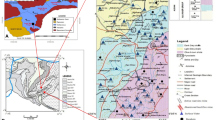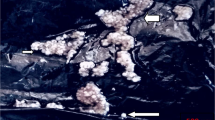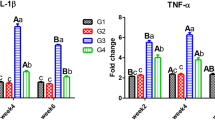Abstract
Water hyacinth (Eichhornia crassipes) has been used in phytoextraction to uptake heavy metals and trace elements in various experiments. This research investigated the protective effects of Water hyacinth extracts on Lead (Pb)-induced toxicity in the albino rat. Forty-eight six-weeks-old Wistar albino male rats (average weight, 180 ± 6.45 g) were divided into six groups: normal control (NC), Pb control (PbC), Chloroform extract (ChEx), Ethyl acetate extract (EAEx), Methanol extract (MeEx) and Ascorbic acid treated groups (AA, positive control). All animals except NC group have been administered with Lead acetate (Pb(CH3COOH)2) before the therapeutic dose. Thrombolytic and cytotoxic effects were evaluated by modified clot lysis and Brine shrimp lethality tests respectively. Biochemical analyses reports revealed that ChEx significantly (P ≤ 0.05) reduced the elevated alkaline phosphatase (ALP) and aspartate amino transferase (AST) whereas MeEx did the alanine amino transferase (ALT) in comparison to positive control. ChEx significantly inhibited the Pb deposition in kidney and liver than two other extracts. ChEx significantly increased the liver protein compared to PbC group. In the thrombolytic assay, EAEx showed the pronounced clot lysis (49.24 %) while ChEx and MeEx showed 45.18 % and 29.13 % of clot lysis respectively. In Brine shrimp lethality bioassay, the LC50 value of the ChEx, EAEx and MeEx were 4.16, 4.47 and 9.27 μg/mg respectively and values were statistically significant (p < 0.05) compared to that of reference cytotoxic agent, Vincristine sulfate (LC50’ 0.55). Histopathological screening of kidney, liver and spleen showed that ethyl acetate extract recovered the highest of the cellular damage caused by Lead acetate. Biochemical and histopathological screening, therefore, demonstrate that Water hyacinth could be one of the promising sources of normalizing the Pb-poisoning and enhancing the thrombolysis in an animal model. Therapeutic prospects of Water hyacinth could be further studied through highlighting a dose-response study.





Similar content being viewed by others
Change history
01 July 2023
A Correction to this paper has been published: https://doi.org/10.1007/s13596-023-00690-6
References
Alluri HK, Ronda SR, Settalluri VS, Bondili JS, Suryanarayana V, Venkateshwar P (2007) Biosorption: an eco-friendly alternative for heavy metal removal. Afr J Biotechnol 6(25):2924–2931
Banerjee A, Chisti Y, Banerjee UC (2004) Streptokinase-a clinically useful thrombolytic agent research review paper. Biotechnol Adv 22(4):287–307
Baruah DB, Dash RN, Chaudhari MR, Kadam SS (2006) Plasminogen activators: a comparison. Vascular pharmacol 44(1):1–9
Bhuvaneshwari R, Mamtha N, Selvam P, Rajendran RB (2012a) Bioaccumulation of metals in muscle, liver and gills of six commercial fish species at Anaikarai dam of River Kaveri, South India. Int J App Biol Pharm Tech 3(1):8–14
Bowers GN, McComb RB (1966) A continuous spectrophotometric method for measuring the activity of serum alkaline phosphatase. Clin Chem 12(2):70–89
Dunsford HA, Sell S (1989) Production of monoclonal antibodies to preneoplastic liver cell populations induced by chemical carcinogens in rats and to transplantable Morris hepatomas. Cancer Res 49(17):4887–4893
Dural M, Goksu MZL, Ozak AA (2007) Investigation of heavy metals in economically important fish species captured from the Tuzla lagoon. Food Chem 102(1):415–421
Dwivedi S (2007) Terminalia Arjuna Wight and Arn: a useful drug for cardiovascular disorders. J Ethnopharmacol 114(2):114–129
Ercal N, Orhan HG, Burns NA (2001) Toxic metals and oxidative stress part I: mechanisms involved in metal induced oxidative damage. Curr. Topics Med Chem 1(6):529–539
Flora G, Deepesh G, Archana T (2012) Toxicity of lead: a review with recent updates. Interdiscip Toxicol 5(2):47–58
Ganguly A, Das S, Dey A, Das R (2012) Optimization of Xylose yield from water hyacinth for ethanol production using Taguchi Technique. IOSR J Pharm Biol Sci. 3(5):01–09
Garaza A, Vega R, Soto E (2006) Cellular mechanisms of lead neurotoxicity. Med Sci Monit 12(3):RA57–RA65
Ibrahim NM, Eweis EA, El-Beltagi HS, Abdel-Mobdy YE (2012) The effect of lead acetate toxicity on experimental male albino rat. Asian Pac J Trop Biomed 2(1):41–46
Jafari N (2010) Ecological and socio-economic utilization of water hyacinth (Eichhornia crassipes Mart Solms. J Appl Sci Environ Manage 14(2):43–49
Krishnaraju AV, Rao TVN, Sundararaju D, Vanisree M, Tsay H-S, Subbaraju GV (2006) Biological screening of medicinal plants collected from eastern Ghats of India using Artemia salina (brine shrimp test). Int. J Appl Sci Eng 4(2):115–125
Lu X, Krustrachu M (2004) Removal of cadmium and zinc by the water hyacinth, Eichhornia crassipes. Sci Asia 30:93–103
Martyn RD, Samuelson DA, Freeman TE (1983) Phenol-storing cells in water hyacinth leaves. J Aquat Plant Manage 21:49–53
McLaughin JL, Rogers LL (1988) The use of biological assays to evaluate botanicals. Drug Info J 32:513–524
McLaughlin JL (1991) Methods in plant biochemistry. In: Hostettmann K (ed) Assay for bioactivity. Academic press, London, pp. 1–32
Meyer BN, Ferrigni NR, Putnam JE, Jacobson IB, Nichols DE, Melaughlin JL (1982) Brine shrimp: a convenient general bioassay for active plant constituents. Planta Med 45:31–34
Pande M, Flora SJS (2002) Lead induced oxidative damage and its response to combined administration of alpha-lipoic acid and succimers in rats. Toxicol 177(2–3):187–196
Persoone G, Sorgeloos P, Roels O, Jaspers E (1980) Proceedings of the international symposium on the brine shrimp Artemia salina; 1979 Aug 20–23; Texas, : Universa Press; 1980. The brine shrimp Artemia
Prasad S, Kashyap RS, Deopujari JY, Purohit HJ, Taori GM, Daginawala HF (2006) Effect of Fagonia Arabica (Dhamasa) on in vitro thrombolysis. BMC Complement Altern Med 7:7–36
Rice-Evans C, Miller N, Paganga G (1997) Antioxidant properties of phenolic compounds. Trends Plant Sci 2(4):152–159
Rincón CTS, Montoya JEZ, Gómez GLC (2014) Optimizing the extraction of phenolic compounds from Bixa orellana L. And effect of physicochemical conditions on its antioxidant activity. J Med Plants Res 8(46):1333–1339
Rorong JA, Sudiarso S, Prasetya B, Polii-Mandang J, Suryanto E (2012) Phytochemical analysis of Water hyacinth (Eichhornia crassipes) of agricultural waste as biosensitizer for ferri photoreduction). Agrivita 34: Accredited SK No.: 81/DIKTI/Kep/2011
Sarker RSJ, Ahsan N, Hossain K, Ghosh PK, Ahsan CR, Akhand AA (2012) Reduction of sodium arsenite - mediated adverse effects in mice using dietary supplemention of water hyacinth (Eichornia crassipes) root powder. Avicenna J Med Biotechnol 4(3):148–154
Sharma P, Jha AB, Dubey, RS, Pessarakli M (2012) Reactive Oxygen Species, oxidative damage, and antioxidative defense mechanism in plants under stressful conditions. J Bot 2012:ID 217037
Sujatha K, Srilatha CH, Anjaneyulu Y, Amaravathi P (2011) Lead acetate induced nephrotoxicity in wistar albino rats. A pathological immunohistochemical and ultrasructural studies. Intl J Pharma Bio Sci 2(2):459–469
Šveikauskaitė I, Šulinskienė J, Sadauskienė I, Ivanov I (2014) The effects of lead and nickel ions on total proteins and metallothioneins synthesis in mice liver. Biologija 60(1):17–21
Waggas AM (2012) Grape seed extract (Vitisvinifera) alleviates neurotoxicity and hepatotoxicity induced by lead acetate in male albino rats. Interdiscip Toxicol 2(2):176–184
Yuan J, Yang J, Zhuang Z, Yang Y, Lin L, Wang S (2012) Thrombolytic effects of Douchi fibrinolytic enzyme from Bacillus Subtilis LD-8547 in vitro and in vivo. BMC Biotechnol 12
Zaoui A, Cherrah Y, Mahassini N, Alaoui K, Amarouch H, Hassar M (2002) Acute and chronic toxicity of Nigella sativa fixed oil. Phytomedicine 9(1):69–74
Acknowledgments
This work was supported by a funding from the University Grants Commission-Dean Research Grant, Bangladesh. Authors are grateful to the Genetic Engineering and Biotechnology laboratories, University of Chittagong, for providing the research facilities to conduct the whole research. The authors are also thankful to the Bangladesh Council of Scientific and Industrial Research (BCSIR) lab, Chittagong-4220, Bangladesh.
Author information
Authors and Affiliations
Ethics declarations
Conflict of Interests
The authors announce that they have no competing benefits.
Ethical Statement
Animals were handled and maintained according to the institutional animal ethical guidelines of the Faculty of Biological Sciences, University of Chittagong.
Rights and permissions
About this article
Cite this article
Ahmed, A.M.A., Khan, S.J., Mojumder, N. et al. Water hyacinth (Eichhornia crassipes fractions potentially normalize the lead (Pb) poisoning and enhance in vitro thrombolysis. ADV TRADIT MED (ADTM) 16, 321–331 (2016). https://doi.org/10.1007/s13596-016-0243-9
Received:
Accepted:
Published:
Issue Date:
DOI: https://doi.org/10.1007/s13596-016-0243-9




